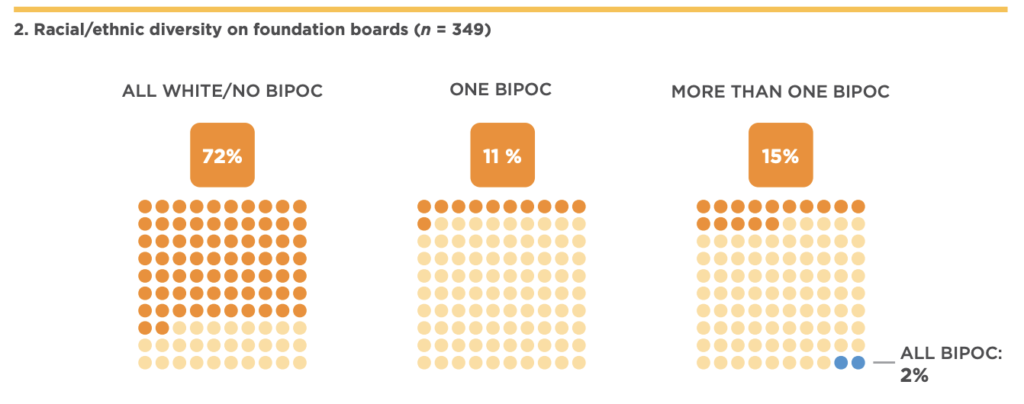
“Philanthropy relies on the amassed wealth of families and institutions that have benefited from systemic racism. As a result, the institution has a power imbalance in where funds go and what organizations and initiatives receive support,” said Maya Pendleton and Juanita Gallion of The Center for the Study of Social Policy in an Exponent Philanthropy blog post. Too often, philanthropy develops or identifies solutions without a race-based lens, even though race is one of the most reliable predictors of life outcomes.
How Lean Funders Are Adding Diversity to Their Foundation Boards and Staff:
Aspiring To Have a Representative Board and Staff
Many funders that have added diversity to their board intentionally seek to hire staff and recruit board members that are both representative of their service region, and have lived experience within the area. For some foundations, aspiring to be representative has been a part of the foundation’s work from the outset. For other foundations, this may be a new goal.
As a result, you may need to reach out to populations the board hasn’t traditionally reached.
Putting Term Limits in Place for Board Members
For many funders, examining term limits for their board members is a crucial step. Increasing board diversity will be nearly impossible if your board has lifetime appointments. Consider implementing or shortening term limits for board members to help create new opportunities for new board members to join the foundation.
Recruiting Board and Staff Members Intentionally
Funders often share the importance of taking a very intentional approach to recruiting board and staff members to ensure their long-term success. This deliberate approach can include a specific racial equity lens when considering new board members. Funders also recommended bringing in multiple board members at once instead of one at a time. This tactic is critical when bringing BIPOC individuals onto a historically all-White board.
Considering Changing From an All Family Board
For family foundations, it can be challenging to add racial diversity to the foundation board. However, by revising the foundation’s bylaws to allow for non-family board members, the foundation can bring in board members who are active in and knowledgeable about the communities the foundation seeks to serve.
Why Racial Equity in Lean Foundations?
The Bridgespan Group and Echoing Green identified two primary factors that keep philanthropy from helping to advance social change:
- An understanding of the role of race in the problems philanthropists are trying to solve
- The significance of race when it comes to how philanthropists identify leaders and find solutions
Being able to listen and having humility, curiosity, and a commitment to continual learning are key qualities needed to start one’s racial equity journey. Many lean funders have these traits.
However, they must first look internally to evaluate how their demographics and operations could be perpetuating racial inequities.
Foundation Board Demographics
The 2022 FOMR compares the entire population of foundation board members to the U.S. population. The report shows that although White people make up 60% of the U.
S. population, 91% of foundation board members are White. Meanwhile, members of the BIPOC community compose nearly 40% of the U.S. population but make up only 9% of foundation board members.

Looking at the specific makeup of individual foundation boards, 72% reported having no board members of color (i.e., had boards entirely comprising people who identify as White). In contrast, only 2% of foundation boards had individuals who identify as BIPOC.

Foundation Staff Demographics
Like foundation boards, foundation staff’s racial/ethnic diversity is low compared to the overall U.S. population. Slightly more than two-thirds (68%) of staffed foundations surveyed have no paid staff members of color; their entire paid staff identify as White.

We observed the same trend when examining CEOs’ racial/ethnic diversity. For example, of participating foundations with full-time CEOs, only 13% indicated having someone in that role who identifies as BIPOC. Meanwhile, only one-quarter (25%) of participating foundations reported having at least one professional/ grantmaking staff member who identifies as BIPOC, and almost one-quarter (23%) have at least one BIPOC administrative/support staff member.

This article’s title implies that it will speak to diversity, but it only speaks to race–an important element of diversity but not everything. Where is disability? Where is level of education? Where is geography? Veteran status? Etc. Without looking at all of the identities and lived experiences that intersect with race too, there are other marginalized identities that will continue to be left out of conversations and strategies.